Add a Comment
Viewing: Blog Posts Tagged with: The Joker, Most Recent at Top [Help]
Results 1 - 5 of 5
Blog: Galley Cat (Mediabistro) (Login to Add to MyJacketFlap)
JacketFlap tags: People, Adaptation, Batman, Alan Moore, DC Comics, Mark Hamill, The Joker, Add a tag
Blog: PW -The Beat (Login to Add to MyJacketFlap)
JacketFlap tags: Television, DC, Gotham, Fox, Showbiz, Top News, The Joker, DC Television, The Red Hood, Add a tag
When Gotham kicked off last year, the show began with a number of proto-versions of Batman’s Rogues gallery such as The Riddler, Catwoman, Poison Ivy, and of course The Penguin (who, played by Robin Lord Taylor, has sort of worked his way into MVP status on the show according to its fans, along with Jada Pinkett Smith’s Fish Mooney).
Just a few episodes into its run, and rumors were already flying around regarding the Joker possibly appearing, either through red herrings in every episode, or even the wild theory that Oswald Cobblepot was actually the Joker.
Today, Executive Producer Bruno Heller has revealed that The Red Hood is coming to Gotham, and as we know, where that hood usually goes…the Joker is soon to follow.
From an interview via CBR:
There’s going to be an episode that involves the Red Hood…which picks up that strand, the costume strand, and sort of gives a kind of philosophical base, if that’s not too pretentious a word. Why costumes? What’s the power of costumes? What’s the power of a mask? All of that groundwork will be laid sort of culturally for that side of the DC Universe before we start rolling into the more spectacular spandex type of deal.
With Bruce at his current pre-teen state, who is going to drive The Red Hood into that infamous vat of chemicals? Perhaps this will be the first of the Red Hood gang and the eventual “Joker-to-be” comes later. Or maybe I’m putting more thought into this than Gotham‘s producers probably have. I’d love to be wrong.
Blog: PW -The Beat (Login to Add to MyJacketFlap)
JacketFlap tags: Jeff Lemire, DC Comics, Green Arrow, Gail Simone, Top News, Guillem March, Greg Pak, Andrea Sorrentino, andy kubert, Darkseid, Derek Fridolfs, Superman, Poison Ivy, The Joker, Villains Month, News, Reviews, DC, Add a tag
DC sent along a lovely pack of review copies for Villains Week, and I feel like it’s only fair that I read through all of the ones out this week and review ‘em. I’ll go from my least favourite to my favourite, ending with my favourite of this first lot. And hey! If DC send along a second selection next week, I’ll review those ones too!
Slight spoilers below, but nothing particular.
One thing that you should note is that some of the comics take place as part of Forever Evil – the Batman and Flash comics, it seems – whilst the Green Lantern/Superman issues are more general. So if you pick up Poison Ivy or Grodd, it’ll make reference to two of the more immediate moments which occur in Forever Evil #1. Keep that in mind as you buy the comics – they’ll all make sense, but some will be directly following on from the main story whilst others are unconnected origin stories.
Desaad
Paul Levitz (w), Yildiray Cinar (a), Jason Wright (c), Carlos M. Mangual (l), Anthony Marques, Mike Cotton (e)
I’m astonished this issue was made. Impossible to understand as a standalone story, it features a sequence about a mass shooting which is in extremely poor taste. The rest of the comic doesn’t explain who Desaad is or what’s going on, and is filled with concepts and ideas which are neither fleshed out nor coherent. The art tells the story – what little there is – well enough, but there are some dodgy character designs going on. I didn’t care at all about Desaad by the end of the issue.
Relic
Robert Venditti (w), Rags Morales (a/i), Cam Smith (i), Andrew Dahlhouse (c), Dave Sharpe (l), Chris Conroy (e)
There’s an interesting story in here somewhere, but the artistic choice made here turns an origin story into a complete chore to read. Every page is a splash page from Rags Morales, and he chooses some absolute clunkers. The first page shows a pretty galaxy with an arm floating into the left frame. What’s going on? Who knows. It’s boring.
Morales doesn’t make any of the concepts in Venditti’s script work, and his character designs are uninspired and uniform. Andrew Dahlhouse does his absolute best to clean up this mess, but it’s a lost cause. I can see that Venditti’s story would be interesting, if only the comic had been told sequentially instead of as a series of misconnected splash pages.
Joker
Andy Kubert (w), Andy Clarke (a), Blond (c), Jared K. Fletcher (l), Katie Kubert (e)
As you might expect, there’s really no reason to try and offer any backstory to The Joker. This issue tells a nonsense side-story from some point in Joker’s past, during which he has some flashbacks to his childhood. Really, any attempt to flesh out the past of the character is always going to flop – the more we know about Joker, the less interesting he is. As a result, the issue flails with an un-involving main story which bombs the final gag, and flashbacks which take away from the story entirely.
Andy Clarke’s artwork is lovely, as always, although the weak script means it’s very difficult to determine how some scenes are meant to be interpreted. There looks to be some intent at offering a subtext, but this is only conveyed in the art and not the script. It seems as though one of the supporting characters is secretly working at a cross-purposes, but there’s only so much the art can do without clear dialogue. Clarke attempts to elevate a completely throwaway storyline, but can only offer a very pretty, very weak, story.
Grodd
Brian Buccellato (w), Chris Batista (a), Tom Nguyen (i), Wes Dzioba (c), Wes Abbott (l), Kyle Andrukiewicz, Joey Cavalieri (e)
Grodd’s a curious character. The main reason he exists as a villain is because gorillas are scary, I guess? This is an issue which struggles because the character comes into this issue with a goal that doesn’t make any sense. Every single character in the comic calls him out for his strange decisions and ambition, and he basically hits them until they give up trying. Does it forgive a strange character if every other character CALLS him strange? I’m not sure on that.
Chris Batista, to me, is one of those artists DC have never appreciated quite enough, and his work here is really good fun – not everybody can draw an expressive gorilla. Not a bad issue by any means, but one which doesn’t manage to quite fix the character.
Cyborg Superman
Michael Alan Nelson (w), Mike Hawthorne (a), Daniel Brown (c), Carlos M. Mangual (l), Rickey Purdin (e)
Interesting, this one. It’s going to upset fans of the character, but tells a reasonably involving story. Framing two sequences against one another, the final few twists are very obvious, although Nelson mines from really fun laughs from Cyborg Superman’s sadistic quest for a sidekick. I don’t know how this actually fits in with established continuity – it would seem to wreck Green Lantern’s past storylines, for example – but we’ll have to see. It’s a perfectly fine comic, and Hawthorne’s art is like somebody put Jamie McKelvie and Stuart Immonen’s art in a blender. Good, in other words.
Two Face
Peter J. Tomasi (w), Guillem March (a), Tomeu Morey (c), Dezi Sienty (l), Darren Shan, Rachel Gluckstern (e)
Featuring an astonishingly drawn and coloured opening sequence between Two Face and Scarecrow whilst both are stood ON the Bat-Signal, the issue sadly then moves into familiar territory for the rest of the issue. Morey’s colouring is spectacular though, especially in the early stages of the issue. At first it feels like there’s a definite plan for the issue, until the story turns into a typical Two Face/anti-hero narrative. There’s nothing especially new here, especially for those who have read No Man’s Land and other stories where Two Face similarly has no Batman opposing him.
It’s entertaining, but it also feels like Tomasi is killing time for the last half of the page-count. There’s some good puns about duality, though, which is half the battle in a Two Face story.
Bizarro Superman
Sholly Fisch (w), Jeff Johnson (a), Andy Smith (i), Javier Mena, Jordie Bellaire (c), John J. Hill (l), Ricky Purdin (e)
This is actually a Lex Luthor story, and it follows familiar ground in an entertaining way. No other character in comics quite has that mix of ambition, arrogance and disregard that Luthor has, and Fisch nails the character. Bizarro Superman himself is a strange creature in the comic – his arc is obvious from the moment he appears. Interestingly enough, Bizarro at no point takes on the design he has in the cover – this is a step far removed from the ‘classic’ rendition of the character.
But despite the by-numbers nature of the narrative, the creative team fit enough touches of silliness and character into the story that the comic works very nicely indeed. I was surprised to find I enjoyed the comic so much, but it was a really solid issue.
Ventriloquist
Gail Simone (w), Derlis Santacruz (a), Karl Kesel (i), Brett Smith (c), Dave Sharpe (l), Katie Kubert (e)
Very much in-tone with her run on Suicide Squad, Gail Simone’s story here puts focus on different mindsets of villainy. One thing the writer has excelled at recently has been creating villains who do evil acts no other villain would do – her Deadshot felt like a unique person rather than a sarcastic goon with a gun, and she’s created some of the most genuinely unsettling villains of the last few years. So it is again with Ventriloquist, which focuses on the second iteration of the villain, Shauna Belzer.
Carefully told, even if it does require a rather large suspension of disbelief towards the end, the story gives us a version of the characters – both ventriloquist and dummy – which keeps readers surprised and unprepared for what might happen next. And when Simone does leave a blatant piece of foreshadowing in the story, she does it to drum up tension and let readers stay one step ahead of the characters. It’s a well-done story, which takes an (probably rightfully) underused villain and give them a bit of purpose and character. It might be deeply silly, but there’s a deadly slice of horror tucked away in there too.
Count Vertigo
Jeff Lemire (w), Andrea Sorrentino (a), Marcelo Maiolo (c), Rob Leigh (l), Harvey Richards, Will Moss (e)
A considered and underplayed issue, Green Arrow’s team make the most of this opportunity to build up one of the character’s most famous villains. Despite a slightly silly design, the character gets a much-needed redevelopment and sense of purpose which feels genuinely menacing. This doesn’t feel like a villain who is insane, but rather a methodical and calculated man who realises that breaking a moral code is preferable to getting left behind.
Sorrentino and Maiolo do some more wonderful work on the issue, continuing their incredible run of form. Sorrentino is the most distinctive and impressive artist at DC, and creates a wonderful sense of space in his work. On one page, for example, he breaks the story into ten page-width boxes, but without any of them feeling cramped on unintelligible. He does masterful work with POV framing, as well – he has an innate sense of perspective which makes it feel as though we’re looking directly out the eyes of the character, without things seeming like they’re overly-crafted and false.
It’s a very very strong issue indeed. Lemire unfolds an inevitable story as his own leisure, and leaves us with the indelible impression that Count Vertigo just became one of DC’s finest.
Poison Ivy
Derek Fridolfs (w), Javier Pina (a), John Calisz (c), Taylor Esposito (l), Kyle Andrukiewicz, Joey Cavalieri (e)
Like with the Two Face issue, this is an exploration in what Poison Ivy does when Batman isn’t around. And again, it’s basically what happened in No Man’s Land. The creative team manage to spread that idea out, however, and fill in some great details about the character and her origin. Also, there’s something quite enjoyable about seeing the character cut loose and have fun, because unlike most other Batman villains, her goal is philanthropically sociopathic. Fridolfs details how her ambitions are almost-so-close to being understandable, and Kalisz’ colours actually go a long way towards aiding that.
In the flashback sequences his colours highlight the character as a total innocent, in bright, warm pastels which makes the reader feel empathetic to her. Pina’s artwork is also excellent, presenting the character over the years as she ages – young and adult Ivy look like each other. I have a soft spot for the character, but the issue doesn’t rest on that hope. Instead, it offers a coherent origin story which binds the character’s personality together and leaves her in a stronger position than before.
Darkseid
Greg Pak (w), Paulo Siquiera, Netho Diaz (a), Hi-Fi (c), Dezi Sienty (l), Anthony Marques, Eddie Berganza (e)
The best issue so far, and likely to be the best of the initiative in general. Greg Pak offers us a talking Darkseid who earns his position as villain #1 in the DC universe. He’s scary and performs crazy, ambitious feats. What’s most notable is how Pak seeds his own just-started stories into the first Justice League story Geoff Johns wrote in the New 52 – it feels seamless and goes a very long way in fixing the problems many readers had with that first story.
A brilliant showcase for Darkseid as a villain, the issue is big and grandiose, explains who he is and why he does what he does, and makes the reader eager to read more Darkseid stories in future.
As I mentioned it in the Joker review, I should also mention it here – it’s a bit strange reading a Darkseid origin story. At the same time, so far in the New 52 Darkseid has been a bit rubbish… so I’m really just happy that the issue deals with him, gets it out the way and pushes the whole thing forwards.
Siquera, Diaz and Hi-Fi offer distinctive, eye-popping visual images whilst letterer Dezi Sienty handles the Kirby-esque dialogue with consummate ease. The ideas presented here could look silly and ridiculous, but for the intervention of Siquira and Diaz as artists. They handle everything thrown at them and turn it from nonsense into a believable (if strained) reality. If there’s one villain issue to pick up – it’s this one, for my money.
And here’s some numbers:
* five of the books are origin stories set primarily in the past
* six are set in the ‘present’ day, after Forever Evil #1
* three of them do not feature the ‘origin’ of the character profiled
* two books have a completely different character in the starring role, rather than the original pre-52 character
* four of the characters have a backstory of familial abuse/murder
* Batman, Superman, Darkseid, Count Vertigo, The Cyborg (Superman) and Desaad all get ‘created by’ credits.
Blog: PW -The Beat (Login to Add to MyJacketFlap)
JacketFlap tags: The Joker, Carol Tilley, Danny Fingeroth, Denny O'Neil, Seduction of the Innocent, book-burning, Dr. Frederic Wertham, Heidi MacDonald, James Reibman, John Ordover, Roy Thomas, Sharon Packer, Soho Gallery of Digital Art, The Comics Code, News, Censorship, Events, History, Comics, Sociology, DC, Marvel, Batman, Joe Shuster, David Hajdu, psychiatrists, Marvel Comics, The Library of Congress, DC Comics, Craig Yoe, Karen Green, Top News, Add a tag
As the first of several “Comic Book Roundtable” events to be held at the Soho Gallery of Digital Art under the auspices of gallery owner John Ordover and former Marvel editor, author, and educator Danny Fingeroth, this event exploring the life and legacy of Dr. Frederic Wertham was planned for the occasion of Wertham’s 118th birthday, but in the lead up to the event, recent developments in scholarship about the controversial comic reformer shed new light on the evening’s subject matter. In February 2013 Librarian, professor, and scholar Carol Tilley discovered, after examining Wertham’s papers held by the Library of Congress, that some of Wertham’s methods and reports were questionable, sparking debate in comics scholarship and among comics fans.
“Surely You’re Joking Dr. Wertham” hit the controversy head-on by bringing together a distinguished panel for discussion, including Tilley, comics writer, editor, and educator Denny O’Neil, author and educator David Hajdu, practising physician, psychiatrist, and author Sharon Packer, and author, editor, art director, and cartoonist Craig Yoe. The Soho Gallery provided excellent accompaniment to the event in the form of Wertham-related images and quotes displayed as a digital exhibit, and hosting a reception afterward.
The evening opened to a thoroughly packed-in audience, among whom were many scholars and authors who have shown a public interest in Wertham’s career and legacy, including James Reibman, the official Frederick Wertham biographer designated by Wertham’s estate. Host and moderator Danny Fingeroth provided an introduction to Wertham in the form of slides including pictures of Wertham in and out of official capacity as a clinical psychiatrist working with children, and also reminded the audience of the other books Wertham authored aside from his now legendary Seduction of the Innocent, a critique on the “influence of comic books on today’s youth”, published in 1954. This placed Wertham within the context of other cultural reactions of the time that questioned the sex and violence being depicted in comics as appropriate for young readers.
Tilley started off the panel discussion by explaining exactly what her recent research has uncovered about Wertham’s work. While her original intention was to locate materials relevant children’s education, she found “other things” that she didn’t expect to find among Wertham’s documents which she found “well-organized” in a “couple of dozen plus boxes” at the Library of Congress. The documents included copies of Wertham’s other research papers and speeches spanning his career, among which she found “discrepancies” and “some indication that he did things like combine the testimony of kids” or “broke apart” the testimony of one child “into four or five” in order to use quotes. This practice also resulted in evidence of “deleted or added” phrases from the children’s testimony that Wertham presented in Seduction of the Innocent and other works. This resulted, Tilley said, in a general “perception” of evidence in Wertham’s book that was “not the same as the actual case” of his research materials. When questioned about whether these changes were negligible or whether they altered the meaning of the children’s testimony, she confirmed that these “additions and word changes did change the meaning of testimony”. While Wertham’s book has often been criticized for its “lack of attribution” in footnotes or bibliography, Tilley feels that she has “seen personally” that his use of sources was not exacting enough. For those interested in Wertham’s legacy, this was something of a bombshell, though Tilley has been public about some of these findings previous to the evening’s discussion.
Hajdu then commented on Wertham as a figure, reminding the audience that Wertham is often a “handy symbol” of a wider movement against comic book excesses, and even a “personification” of the “cynicism toward comics in the late 40’s and 50’s”, even though he didn’t start this trend personally. Hajdu explained that even “newspaper comics incited criticism” prior to Wertham’s career and were often perceived as “crude, anti-literate” and examples of “defiant behavior” that raised public concern. The Catholic Church, particular, he noted, were active in inspiring state legislation against comics, due to their belief in the “power of aesthetics and the power of art” for both positive and negative influences on human behavior.
[Packer, Yoe, and Fingeroth]
O’Neil, himself raised Catholic, confirmed that his “first encounter with the (comic) witch hunters was in the pages of The Catholic Digest” and that he, as a young person “read and believed” that superhero comics, particularly, were potentially harmful. He related, to the audience’s amusement, that former Marvel editor Roy Thomas “as a kid” had participated in a book burning in Missouri where he “burned comics he was not interested in”, but rescued others he liked. Tilley briefly added that she had discovered evidence that librarians, too, had participated in comic burning and attempted to keep them out of libraries during this period because they were seen as “disruptive”.
Packer suggested that Wertham’s book title, Seduction of the Innocent, might have spoken particularly to a Christian demographic because of its suggestion of the massacre of the innocents by King Herod related in the New Testament of the Bible. This led to a reassessment among the panellists of Wertham’s title, since its original version was “All Our Innocents”. Fingeroth pointed out that this change made the title “very pulp sounding” and therefore more sensational.
Yoe’s background on the subject of juvenile delinquency as an author, and also his discovery of the “fetish art” of Joe Shuster confirmed that there were real-life implications for the more violent aspects of comic art, such as the case of the Brooklyn Thrill Killers who killed indigent people and molested women and when interviewed by Wertham as an expert witness, confessed to being inspired in their deeds by Shuster’s artwork. Yoe, however, prompted a wide-ranging and at times heated discussion on the subject of exactly how and when Wertham’s papers at the Library of Congress had been made available for research purposes. Both Yoe and Hajdu, upon requesting access in the past, had been denied use of the papers since they were “sealed” until the children who participated in the studies had passed away. “In many ways, I respect Dr. Wertham”, Yoe said, but “the Library of Congress is our library” and its contents “should be seen” regardless of the circumstances behind their compilation. Outspoken attendee and Wertham biographer Reibman, who was granted access to the papers at a much earlier date in order to work on his book, disagreed with Yoe’s statement in favor of “freedom of information”, arguing that sealing Wertham’s papers at the library was part of the “terms of the gift” to the library. Reibman’s frequent interjections on behalf of Wertham during the event contributed to a rather heated atmosphere.
Yoe questioned further why some individuals, and not others, were then granted access despite the terms of the gift. Hajdu chimed in that he had requested access “dozens of times” but had been denied despite his academic credentials. Yoe asked Tilley if, based on her experience as a librarian, this discrepancy was “unusual” or not. Tilley confirmed that in her experience, the sealing of the papers while at the Library of Congress and then granting access to only those individuals sanctioned by the estate of the deceased, was indeed “unusual”. Attendee Karen Green, Graphic Novels Librarian at Columbia University, also commented that while “archives can be restricted”, for public documents this practice is “not usual”. Tilley provided further information about the situation by explaining that she was obliged to sign an agreement with the Library of Congress about the materials she accessed, even though a large portion of the Wertham papers consisted of “newspaper clippings” which “shouldn’t be restricted” anyway. Yoe brought some levity to the rapid fire questioning and often terse dialogue between he and Reibman by pointing out that Hajdu closely resembled a young Frederic Wertham and ought to have just turned up at the library, saying “I am here to see my papers”. Though Hajdu found the comparison amusing, he said “That’s the most offensive thing I’ve ever heard”.
[O'Neil and Hajdu]
Fingeroth then gathered the reigns of the discussion as moderator to direct attention back to the panelists and away from the discursive arguments breaking out among audience members. Fingeroth asked O’Neil, specifically, if he had felt any “lingering hesitation” about comics after his experience with The Catholic Revue in childhood. O’Neil related that Wertham’s legacy, but particularly the Comics Code had impacted his career in comics. He was involved in “several public arguments” with administrators at comics publishing companies, wherein comics supporters felt the need to argue “comics are good, not evil anymore”. O’Neil’s personal feeling has always been, and still is, he said, that “If it’s censorship, it’s bad”, and often felt frustrated by the “vagueness of the language” in the Code itself, often leading comics creators to create elaborate avenues to get around the letter of the Code. He related a particularly frustrating incident where an IRONMAN story involving a “six story tall monster” crushing a police car was censored because it “showed disrespect to the police car” even though it also showed policemen being very brave in their fight against the monster. This kind of “idiocy” in the Code he particularly objected to, and added his motto that “blind worship of authority figures whether or not authority figures had any authority” should never be supported.
At this point, it was relevant to clarify that Wertham was not the founder of the Comics Code, though his work certainly paved the way for its development. Yoe reminded the audience that Wertham was, in fact, a progressive who was in support of the freedom of the press. It was more that Wertham “created the climate”, O’Neil supplied, which led to the Senate hearings, which led to the drafting of the Code. Both Yoe and O’Neil agreed that comics publishing was, in fact, in a very low economic position at the time of the Senate hearings anyway, due to the rise of paperback novel sales and TV watching. Yoe and O’Neil continued to discuss whether a “rating system” couldn’t have been created, rather than the unilateral Comics Code, in order to steer children away from more disturbing comics. Hajdu pointed out that the rating system was not in effect in Hollywood, by comparison, until the 1960’s, so there was not a particularly clear model to instate for comics at the time.
Fingeroth asked the panelists, and in particular, Packer, whether Wertham’s research was purely “anecdotal” or whether he furnished “hard statistics” when working with children. Packer provided some context as a clinical psychiatrists about the methods of the time during Wertham’s career. She compared Wertham to Sigmund Freud and pointed out that though “Freud was celebrated at that time”, “much of his original psychological literature” was “just as baseless” as Wertham’s methods. Tilley added that her survey of Wertham’s papers revealed that his “data was rich”, but it was just “how he used it rhetorically” that was “questionable”. Yoe commented that even though his rhetorical use of his data might lead us to view Wertham with increased suspicion, in the big picture, Wertham made a “pretty good case. Many comic books were not good for young children” in term of their content.
[Tilley and Packer]
Fingeroth took the question to a finer point. Did Wertham, he asked, in the opinion of the panelists, “take too many liberties” or not? Tilley stood her ground by asserting that “scientific investigation” requires accuracy, and a failure of accuracy is troubling from a scientist. Tilley added that her “personal sense” from working with the papers is that Wertham “cared more about getting rid of the comic book industry” than about his public cause of helping children develop in a psychologically healthy atmosphere. Though he certainly “cared for kids”, she reminded, she still felt that Wertham used children as “leverage” to achieve this greater goal of attacking the comics industry. One of the things that gave her a less than sterling impression of Wertham’s personality was discovering detailed transcripts that he “noted meticulously” of phone conversations that contained potentially harmful gossip about people who he saw as enemies in his career. He “collected information”, she said, “looking for weak spots” in the lives of people he wanted to undermine, particularly people who acted as “consultants for the comic book industry”.
Fingeroth asked about Wertham’s movement, in his later career, toward criticism of the film industry and whether Wertham might have seen “comics as a stepping stone to a higher agenda” as a “career path”, but the general consensus among panelists seemed to be that comics were more easily attacked as a less profitable industry early in Wertham’s career, and that the tide of criticism had generally turned toward film around the time of Wertham’s developing interest in film. Film itself had, by the mid to late 60’s, become more overtly violent with works like Bonnie and Clyde.
The rather charged atmosphere during the panel discussion gave way to an extensive question and answer period involving the audience and spanned a number of subjects. Did the distaste the comic book industry came to feel for Dr. Wertham result in a generally negative portrayal of psychiatry within comics? Yoe agreed that there are certainly plenty of “sinister psychiatrists” portrayed in comics tradition, and Packer supplied examples from Batman mythology including the Arkham family. O’Neil added that the character Harley Quinn was originally assigned to “cure” the Joker of his madness and instead was “driven nuts” herself. A more pointed question was posed about whether the possibility that Wertham skewed his evidence really made the questions he was asking about the role of comics at the time irrelevant. Hajdu fielded this question by commenting that the “weakest criticism of Wertham is that comics can’t affect minds and hearts”. As an art form, Hajdu argued, comics certainly do have impact and can “transform people”. “Comics have that power”, he reminded.
O’Neil weighed the issue by confessing that as a comics creator “You launch a given work and you have no way of knowing how it’ll bounce” and he often worried during his early career what impact particular comic stories might have on “kids already imbalanced”. O’Neil gave and example of his decision-making when he declined to include a “martial arts move” in one of his comics because it was “simple and damaging” and judged that kids might too easily learn to implement it. The audience, of course, immediately wanted O’Neil to demonstrate the deadly move, but he refrained in the interest of safety. For the same reason, O’Neil never allowed Molotov cocktails in his works, sure that it was too much of a “temptation” for kids to “see if it would work” building their own.
The Beat’s own Heidi MacDonald asked a rather burning question from the floor, one that continues to puzzle readers and comics historians alike: “Why do you think he attacked comics specifically? What did he hope to get out of it?”. The panelists answered in various ways. Yoe felt pretty strongly that Wertham was, in fact, motivated primarily by the fact that he “cared about kids” and was worried about the impact of comics. Packer analyzed Wertham a little by pointing out that Wertham himself, despite being married for many years, had no children of his own and this might have created a kind of “displacement” of concern for children that drove him to extremes. Hajdu simply stated that he felt Wertham to be “attracted to sensationalist cases” whether as an expert witness in extreme criminal cases or his research. He was, Hajdu said, a “publicity hound” at heart. Even Yoe added the admission that without a doubt Wertham had a “raging ego” driving his career.
Questions continued to circle back to the central role of Tilley’s new research on Wertham’s inconsistencies. How do we reassess Wertham based on the incorrectly conveyed details of his research, which clearly skewed his information in order to more sensationally and fundamentally support his thesis, when the “big picture” of his message, that extreme violence and sex in comics can be inappropriate for child readers, does seem sensible? Fingeroth presented a list of Wertham’s more “progressive” tendencies, stating that it’s possible to “go through a checklist of Wertham’s beliefs and agree except for comics” and respect many of his social contributions.
The final assessment of the panelists revealed some consensus out of a wide-ranging interrogation of Wertham’s method and legacy. O’Neil reminded the audience that Wertham was certainly not the “black-hearted villain” that many comics fans feel him to be, but he did detrimentally present those working in comics, “demonizing” them and making them out to be the “seducers and corruptors” of society, a crusade that damaged comics for decades to come. Yoe felt that the fundamental problem with Wertham’s whole approach to his subject was not necessarily the assumption that comics could be damaging to young minds, but that he “didn’t see that comics could be an art form”, and never commented on their positive potential as an “educational” resource. Yoe left the audience with the question, a lingering one, “Why couldn’t he see that?”. If Wertham had seen the potential of comics as a positive force, no doubt our current view of his work would also be more balanced on the whole.
[The panelists and their moderator]
A predictably lively, but amicable, discussion period followed during the reception for the event, but if attendees expected definitive answers about the implications of Tilley’s new research on Wertham, they were left to their own devices. The panel discussion did provide solid context for Wertham’s life, work, and even a little for his motivations, as well as some solid information on what exactly Wertham’s failings as a researcher might be. Whether audience members were “pro-Wertham” or “anti-Wertham” initially, the discussion opened up new facets of his personality and work for further thought. Frederick Wertham may be less of a mystery now in the light of new research, but if anything, he’s even more of an enigma, confirmed as a complex figure. Learning more about Wertham changes perception of comics history, and that’s bound to change even more as scholars pay closer and closer attention to the records left behind in collections, personal archives, and thankfully, libraries.
The Comic Round Table events will continue this Spring at the SOHO Gallery for Digital Art with another hot topic in comics right now, the openly anti-gay position of Orson Scott Card and his work on SUPERMAN entitled “The Man of Steel vs. Orson Scott Card” on April 10th.
Hannah Means-Shannon writes and blogs about comics for TRIP CITY and Sequart.org and is currently working on books about Neil Gaiman and Alan Moore for Sequart. She is @hannahmenzies on Twitter and hannahmenziesblog on WordPress.
Blog: PW -The Beat (Login to Add to MyJacketFlap)
JacketFlap tags: Reviews, Comics, DC, Batman, HYPE!, Top News, Scott Snyder, Greg Capullo, The Joker, Add a tag
TweetScott Snyder and Greg Capullo’s Batman #17 came out this week, concluding their ‘Death of the Family’ storyline to universal approval from reviewers. But in all the rush to celebrate and praise, there’s been precious little evaluation of the book itself — many of the reviews, in fact, read more like a pre-emptive defense of the [...]







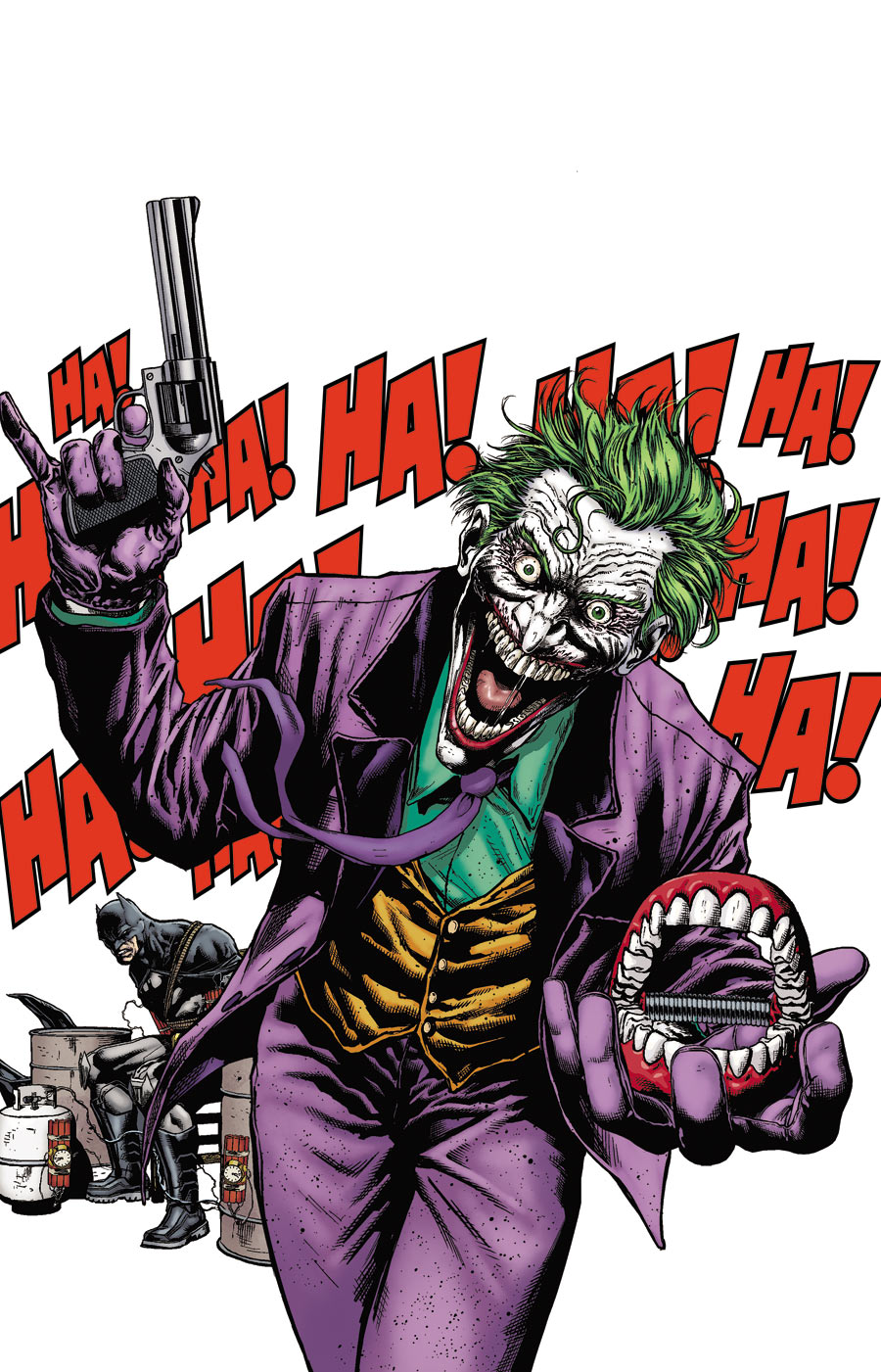


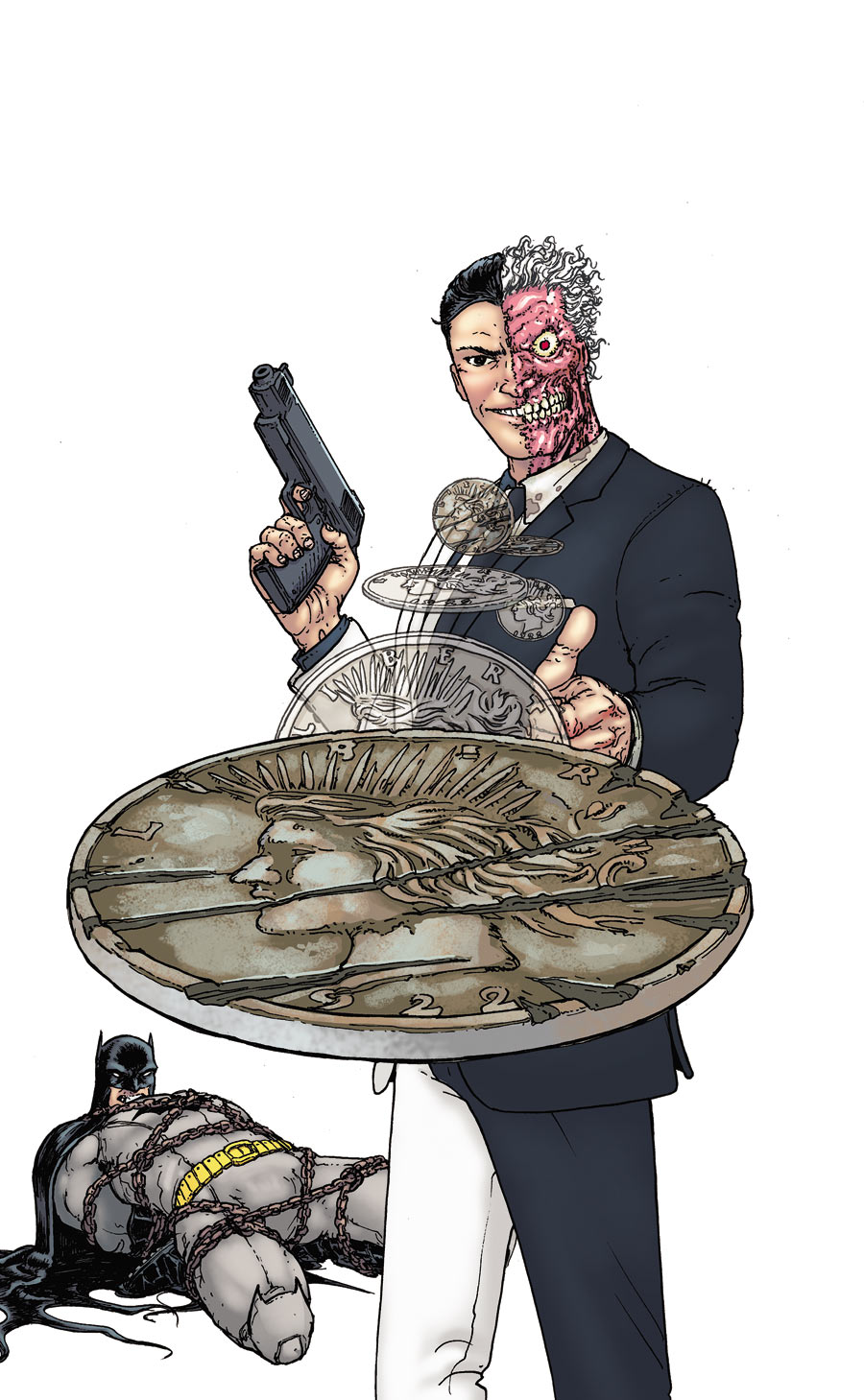
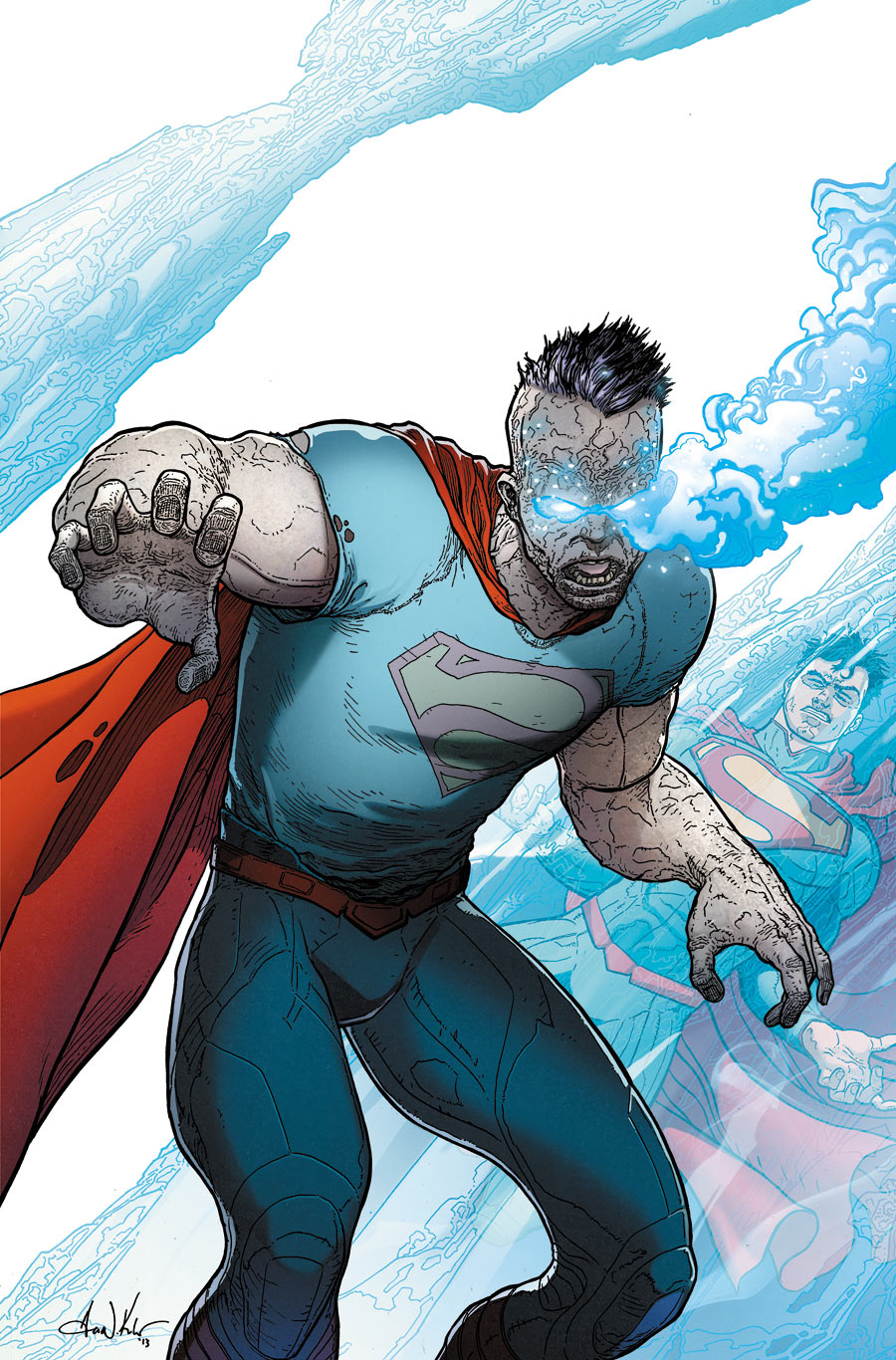






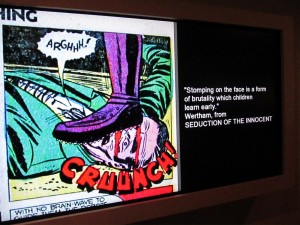
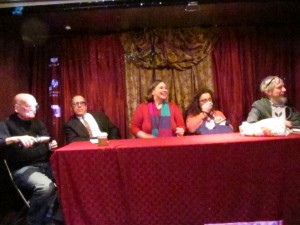
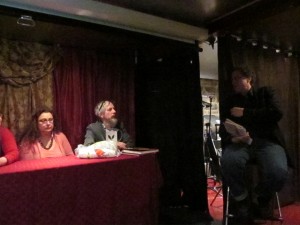
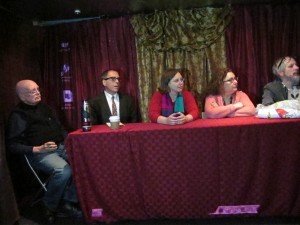
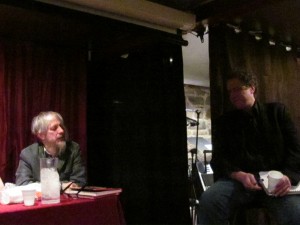
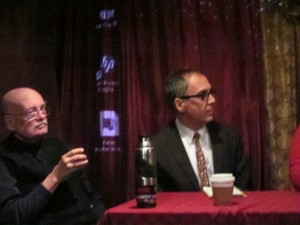
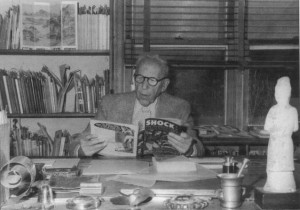



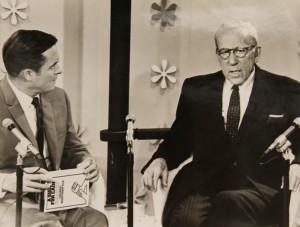



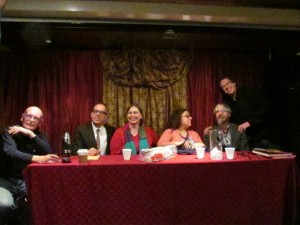
The New52 teased that Gotham had numerous masked gangs before Batman showed up.
In the comics, it seems that Joker has been spliced with Hush, becoming a master tactician and master of disguise. (How did he know so much during “Death of the Family”?)
Snyder’s Batman work seems to use masks as an underlying theme.
I get the impression that someone working on this series has a checklist of every recurring character connected to Batman (superheroes excepted), and is working their way thru it.